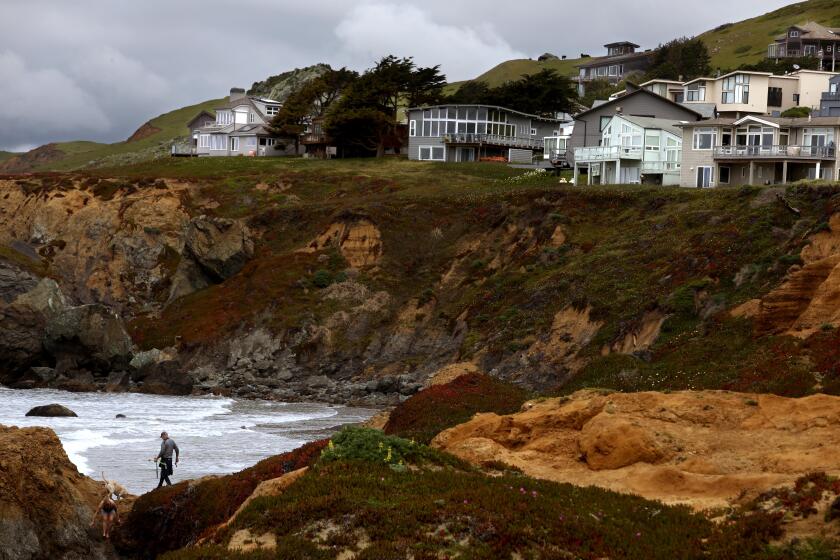Isle of Menacing Cliffs
Just off the end of Ireland’s Dingle Peninsula lies the Great Blasket, one of the best-preserved sources of the Gaeltacht, the Gaelic-speaking culture of western Ireland. It’s an island of gentle grassy slopes and menacing cliffs.
Five miles long and a mile across, the Great Blasket is also the largest of six islands in the Blasket group. Anyone who saw the film “Ryan’s Daughter” might remember it.
From the promontory point of Slea Head, the Great Blasket looks to be an extension of the mainland, but it’s separate, by three miles and perhaps 100 years. And with its mist-shrouded rock ruins and a surprisingly rich body of literature that emerged from its tiny settlement, the Great Blasket Island has a look and feel all its own.
But you can’t always get here. Motor craft leave regularly from the mainland village of Dunquin to cross Blasket Sound; that is, unless the weather dictates otherwise. And it often does.
The dazzling green hills and blue skies can change with a breathtaking swiftness--the slopes cover themselves with mist, the sky hides behind an ominous black, and the sea releases furies of its own. Boats, even motorboats, stay home.
Men Were Fishers
In another time the men of the Blasket knew well enough to respect the weather. Many were fishermen who plied these waters in black currachs, six-oared canoes of lath framework and tarred canvas.
Through long nights they took out lobster, mackerel and whatever else the waters yielded. And at home their families raised cows, sheep, chickens and pigs. They scaled the cliffs in search of bird eggs, and scratched a meager sustenance from the rocky soil. It was not an easy life.
But the villagers would have it no other way. Denied economic abundance, they took comfort in the homogeneity of their culture, as demonstrated by their faith, their close-knit camaraderie and the traditions that they passed from one generation to the next--especially the art of storytelling.
Recognizing the special clements and fragility of their society, some of the villagers, especially Tomas O’Crohan, began to describe it in writing: “To set down the character of the people . . . so that some record of us might live after us, for the like of us will never be again.”
O’Crohan, first of the Blasket’s published writers, wrote (in Gaelic) “Island Cross-Talk, Pages From a Diary” during the years 1919 to 1923. Fisherman, farmer and stonemason, he chronicled daily life on the island. With “The Islandman,” published in 1937, O’Crohan told the story of his life, and not a happy tale it was.
The contagion of measles, drownings in the treacherous surf, a misplaced foot and a fall from the cliff . . . these tragedies were a reality of island life. Yet with a marvelous feel for language, its rhythm and simplicity, the book lifts itself above the sadness.
O’Crohan Built Houses
In the early 1900s, O’Crohan helped build the three newest houses in the village, and off and on they have been used as guest houses for overnight visitors.
Peig Sayers, author of “An Old Woman’s Reflections” and perhaps the finest of the Blasket’s storytellers, lived for many years in one of them.
In the words of O’Crohan, the island was “full to the lid of songs and stories,” and, as the villagers gathered around a peat fire, “sayers,” with a seemingly inexhaustible memory, would regale them with long tales from the deep past.
A visitor, after listening to her, once said, “I never heard anything so moving in my life. I came out of the house and I didn’t know where I was.”
But the best-known of the Blasket writers was Maurice O’Sullivan, whose autobiography, “Twenty Years A-Growing,” sold well in the United States after its publication in 1933.
O’Sullivan wrote of his boyhood in the first years of this century: the perilous quests for birds and bird eggs along the cliffs, the sojourns to the island of Inishvickillaun for seals and rabbits and, of course, his family life.
From his grandfather he learned the Gaelic proverb describing the life span: “Twenty years a-growing, 20 years in bloom, 20 years a-stooping, and 20 years declining.”
Despite the closeness of families, lack of economic opportunity eventually drove them away. O’Sullivan, seeing his sisters one by one leave for America, heard the old people’s lament: “Oh, musha, Maura, how shall I live after you when the long winter’s night will be here and you not coming to the door nor your laughter to be heard!”
Money channeled back from America helped support life on the Blasket until 1953, when, all the young people gone, 25 aged survivors left the island to accept government housing on the mainland.
Roofless Homes
O’Sullivan’s house remains; like most of the others it is roofless now, a shell of rock and mortar slowly giving way to the wind and rain . . . and to time.
Facing the mainland and built along the island’s most protected slope, the houses connect to each other by a series of rock-lined paths.
Just north of the village lies the Strand, a broad, flat stretch of beach where families would gather to collect seaweed for fertilizing the soil. Sometimes they would reap more bountiful harvest--the salvage from ships unable to navigate the hazardous waters of the sound.
A vessel from the ill-fated Spanish Armada went down here; during World War I, remnants from torpedoed cargo ships drifted in along the beach.
The Strand is desolate now, and so, too, is the village, apart from the hordes of rabbits that have reclaimed the island.
The night I stayed on the Blasket I walked among the dark, silhouetted ruins, their craggy walls guarding the secrets of a vanished society.
On one such a night O’Sullivan himself had walked through the village and reflected on his past: “I seem to see before me, full of bright laughter, all the boys and girls who were with me when I was a child. I see them running down the lanes and hiding themselves--the game we used to paly in the moonlight.”
-- -- --
Lelia O’Connor operates the Great Blasket Guest House, which is open during summer only. Although there are no telephones on the island, reservations can be made through the passenger ferry service or by writing to O’Connor c/o Great Blasket Guest House, Dunquin, County Kerry, Ireland.
Sign up for The Wild
We’ll help you find the best places to hike, bike and run, as well as the perfect silent spots for meditation and yoga.
You may occasionally receive promotional content from the Los Angeles Times.



